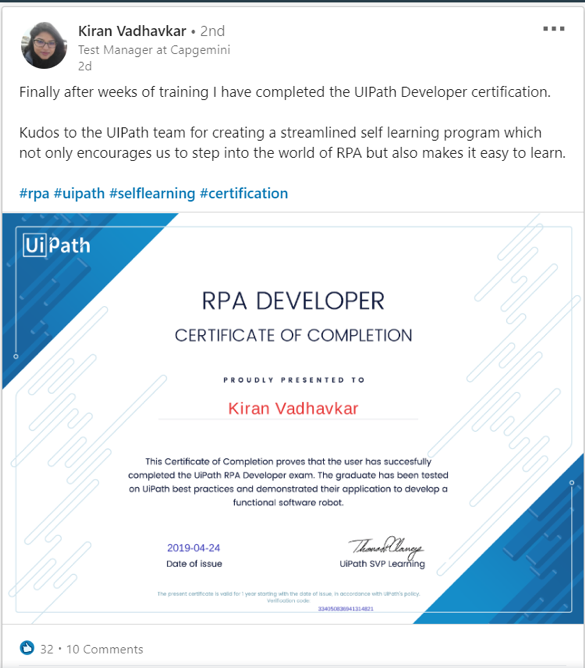RPA and Big Data: The Perfect Match?

It’s clear by now robotic process automation has arrived as one of the leading process streamlining technologies in today’s market. But another technological advancement in data processing and storage is also making waves across a variety of industries and presents intriguing possibilities for companies when stacked against RPA. We’re talking about the advent and proliferation of Big Data and its impact on how companies - and even entire industries - gather, analyze, and share reporting and advanced metrics to refine business processes and achieve defined benchmarks or goals.

According to McKinsey, a global leader in management consulting, “the amount of data in our world has [recently] been exploding, and analyzing large data sets—so-called big data—will become a key basis of competition, underpinning new waves of productivity growth, innovation, and consumer surplus...Leaders in every sector will have to grapple with the implications of big data, not just a few data-oriented managers.”
In other words, much like RPA, Big Data is a technological trend that’s becoming significantly transformative across every industry, and in our increasingly digital world, the amount of captured data is expected to grow exponentially in the coming years.
This alignment between RPA and Big Data has led some industry analysts to question whether these two platforms can be coordinated to function in conjunction with each other for enhanced optimization of back office - and even front office - tasks.
But would such a partnership actually function? What are the value propositions in coordinating these two technologies? With the help of RPA and its focus on automating repetitive tasks, combined with the insights from Big Data, it’s possible companies can combine data and action to operate on truly lean principles, providing increased visibility and transparency across a company’s entire value chain.
Defining Big Data
Though Big Data has certainly permeated such industries and automotive, manufacturing, and a host of others, a consensus on the definition of the term Big Data is somewhat tricky and up for debate depending on the analyst and industry. Forbes suggests twelve definitions. The MIT Technology Review considers six different meanings suggested by companies like Gartner, Oracle, Microsoft, and Intel. Since there’s some flexibility, it’s important to clarify what Big Data is and specifically how it can be manipulated in the context of RPA.
Big Data can be defined as any compilation of unstructured data — on the open web, in a company’s databases, or even from social media. The data can include product pricing information, customer records, and web browsing history. It’s accumulated quickly, is complex in its variety, and exists in massive volumes — essentially, Big Data is a volume endeavor, at least in the beginning. Yet, even without an initial structure, Big Data has tremendous worth given the ability to apply computing and analytical power to it. Big Data’s true value emerges when this data becomes structured. Through the application of algorithms, analytical techniques, or software technologies, Big Data can help companies accomplish deeper inquiry and a better understanding of what their data means. When analyzed and structured in this way, Big Data can become an increasingly useful tool to extract knowledge from the large quantities of information that companies are constantly collecting.
Examining Big Data more closely can expose patterns that were previously hidden or not as evident. The recognized trends can point to places where processes are already optimized, but, more importantly, they can also reveal problem areas and deficiencies in back office tasks. Once these weak points are identified, companies can specifically target them for improvement.
Connection between RPA and Big Data
This process of extracting meaning from Big Data is one where RPA is invaluable, as it can provide analytical capabilities to examine data across disparate data systems. Yet, how specifically do RPA and Big Data work together? What can companies learn from utilizing both to the greatest extent? RPA is a tool that not only generates Big Data, but it also provides useful analysis to obtain its value. The insights provided by the collaboration between RPA and Big Data can be used to recognize hiccups within business processes and help companies streamline these points within their operations.
For example, software robots track and record their own actions, whether automating data entry, claims or order processing, or copy-paste tasks, as well as have the ability to gather information about customers. Robots can provide much more information than a human employee, but all this generated data isn’t really useful without analysis, another vital capacity RPA can provide. The analytic potential of RPA can be used to examine and make sense of this collected information. For example, an online retailer collects data from multiple sources about a shopper’s buying habits, including product preferences and desired price range. By using RPA to link data sources, this information can be compared to the company’s current offerings and company will be able to more effectively offer the customer certain products and promotions.
As seen here, Big Data can be evaluated to gain information about customer needs and desires, but it can also provide an understanding of internal business activities, both in the back office and the front office. RPA can provide data analytics on the number of transactions software robots have completed and the time taken to do so; the transactions that generated exceptions; and required human intervention, as well as the time needed to finishing running current tasks.
While the knowledge gleaned from Big Data by RPA is, of course, useful, it becomes exponentially valuable for organizations when acted upon. In a whitepaper by Digital Intelligence Systems, a global staffing and IT consulting company, it’s suggested that “the use of big data analytics through proper RPA installations can pinpoint actionable tasks for improvement and optimization. Turning large amounts of raw data into understandable patterns for institution decision-making is where the true beauty of RPA is discovered.”
Only through responding to this uncovered information can companies leverage the benefits of automation and advanced data process and analysis.
Why This Matters?
Automation, such as the kind provided via RPA, is one of the avenues through which Big Data can become valuable and transformative. With the information provided from Big Data and the analytics provided by RPA, it becomes exponentially easier for companies to gain insight about customers, business patterns, industry trends, and internal workings. By exercising some initiative in response to RPA combined with Big Data, companies can use the insights gained to make business processes more efficient, thereby saving time and increasing accuracy. Further, by gaining a more robust understand of customers, companies will also be able to offer services in a more targeted and personalized way, thus ensuring a more viable, competitive business platform.
While the process of analyzing data and applying these new insights to current business activities is still dependent on human direction, the relationship formed by merging RPA and Big Data is incredibly beneficial. RPA is currently one of the best tools that can be used to extract insights from Big Data in order to substantially reduce process bottlenecks and increase optimization of business outcomes.

Content Developer, Trekk
Get articles from automation experts in your inbox
SubscribeGet articles from automation experts in your inbox
Sign up today and we'll email you the newest articles every week.
Thank you for subscribing!
Thank you for subscribing! Each week, we'll send the best automation blog posts straight to your inbox.



